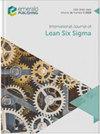区间2型模糊环境下基于信念的汽车行业精益售后服务QFD-AHP模型
IF 3.7
2区 工程技术
Q2 ENGINEERING, INDUSTRIAL
引用次数: 3
摘要
目的本文的目的是提出一种新的精益管理工具,在精益实施中,在将客户声音转化为技术特征的同时,提供一个全面灵活的评估模型。为此,在区间2型模糊(IT2F)环境中,通过置信空间评估、质量函数部署(QFD)和层次分析法(AHP)构建了所提出的模型。该模型包括三个阶段:确定与IT2F集合的语言权重和基于信念的关系,处理关于基于IT2F的信念评估的信息,以及使用解模糊的基于信念的相对重要性值对技术特征进行排序。发现所提出的模型已应用于土耳其的汽车售后服务,以证明其在精益服务决策中的应用。将该模型与经典模糊模型和1型模糊模型进行了比较。所提出的模型的排名结果与其他版本的结果不同。原因是IT2F环境提供了对模型语言量表的敏感和灵活的评估。研究局限性/含义对于从业者来说,拟议模型中的计算可能相当复杂。创建了一个Excel仪表板以简化计算复杂性。实际含义研究人员/从业者可以将此模型应用于任何精益制造/服务实施。社会含义公司经理/员工/客户可以通过信念空间评估来识别他们的感知机制,并体验感知机制中的不确定性如何影响他们的决策。独创性/价值由于贝叶斯模型与QFD-AHP在IT2F环境中的结合,该模型提供了一种新的精益工具。该模型消除了基于概念变化的精益决策中的模糊性。本文章由计算机程序翻译,如有差异,请以英文原文为准。
A novel belief-based QFD-AHP model in interval type-2 fuzzy environment for lean after-sales service in automotive industry
Purpose
The purpose of this paper is to propose a novel lean management tool to provide a comprehensive and flexible evaluation model while converting customer voices into technical characteristics in lean implementations.
Design/methodology/approach
For this purpose, the proposed model was constructed by belief space-evaluations, quality function deployment (QFD) and analytic hierarchy process (AHP) in interval type-2 fuzzy (IT2F) environment. This model involves three phases: determining the linguistic weights and belief-based relations with their IT2F-sets, processing information about IT2F-based belief-evaluations and ranking the technical characteristics using the defuzzified belief-based relative importance values.
Findings
The proposed model was applied to automotive after-sales service in Turkey to demonstrate its use in lean service-decisions. This model was compared with its classical and type-1 fuzzy versions. The ranking-results of the proposed model differed from those of the other versions. The reason is that the IT2F-environment offers a sensitive and flexible evaluation of the model’s linguistic scales.
Research limitations/implications
Calculations in the proposed model may be quite involved for practitioners. An Excel-dashboard was created to simplify the computational complexity.
Practical implications
Researchers/practitioners can apply this model to any lean manufacturing/service implementation.
Social implications
Company managers/employees/customers can recognize their perception-mechanisms via belief space-evaluations and experience how uncertainty in the perception-mechanism affects their decisions.
Originality/value
The proposed model provides a new lean tool due to the Bayesian model combined with QFD-AHP in IT2F-environment. This model eliminates the ambiguity in conceptual change-based lean decisions.
求助全文
通过发布文献求助,成功后即可免费获取论文全文。
去求助
来源期刊

International Journal of Lean Six Sigma
Engineering-Industrial and Manufacturing Engineering
CiteScore
8.90
自引率
15.00%
发文量
46
期刊介绍:
Launched in 2010, International Journal of Lean Six Sigma publishes original, empirical and review papers, case studies and theoretical frameworks or models related to Lean and Six Sigma methodologies. High quality submissions are sought from academics, researchers, practitioners and leading management consultants from around the world. Research, case studies and examples can be cited from manufacturing, service and public sectors. This includes manufacturing, health, financial services, local government, education, professional services, IT Services, transport, etc.
 求助内容:
求助内容: 应助结果提醒方式:
应助结果提醒方式:


